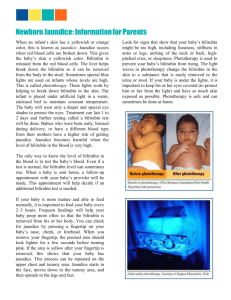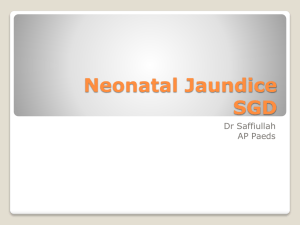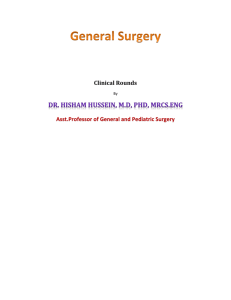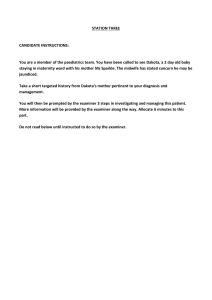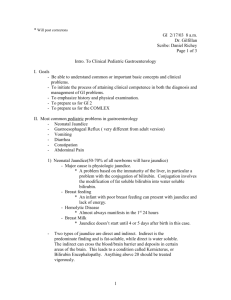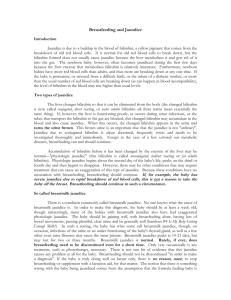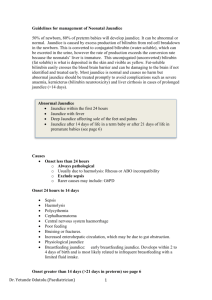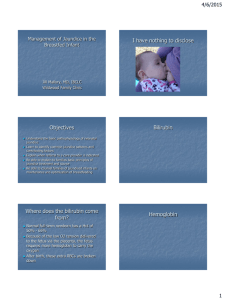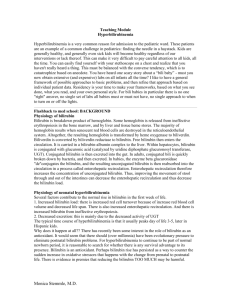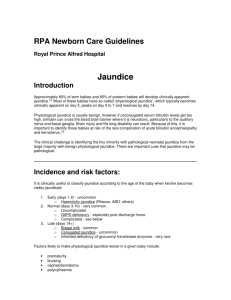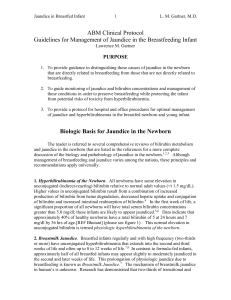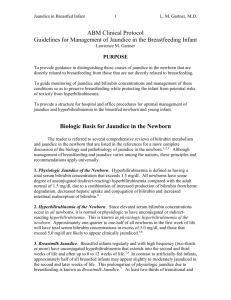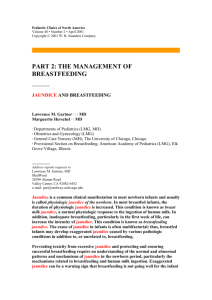The First Days of Life
advertisement
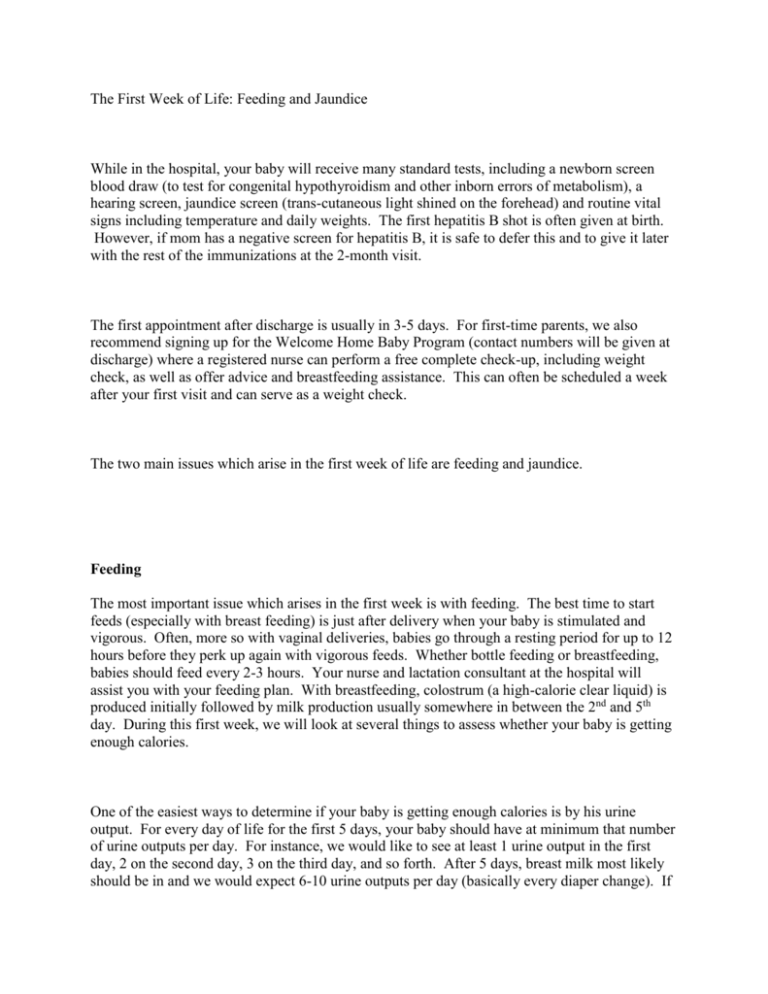
The First Week of Life: Feeding and Jaundice While in the hospital, your baby will receive many standard tests, including a newborn screen blood draw (to test for congenital hypothyroidism and other inborn errors of metabolism), a hearing screen, jaundice screen (trans-cutaneous light shined on the forehead) and routine vital signs including temperature and daily weights. The first hepatitis B shot is often given at birth. However, if mom has a negative screen for hepatitis B, it is safe to defer this and to give it later with the rest of the immunizations at the 2-month visit. The first appointment after discharge is usually in 3-5 days. For first-time parents, we also recommend signing up for the Welcome Home Baby Program (contact numbers will be given at discharge) where a registered nurse can perform a free complete check-up, including weight check, as well as offer advice and breastfeeding assistance. This can often be scheduled a week after your first visit and can serve as a weight check. The two main issues which arise in the first week of life are feeding and jaundice. Feeding The most important issue which arises in the first week is with feeding. The best time to start feeds (especially with breast feeding) is just after delivery when your baby is stimulated and vigorous. Often, more so with vaginal deliveries, babies go through a resting period for up to 12 hours before they perk up again with vigorous feeds. Whether bottle feeding or breastfeeding, babies should feed every 2-3 hours. Your nurse and lactation consultant at the hospital will assist you with your feeding plan. With breastfeeding, colostrum (a high-calorie clear liquid) is produced initially followed by milk production usually somewhere in between the 2nd and 5th day. During this first week, we will look at several things to assess whether your baby is getting enough calories. One of the easiest ways to determine if your baby is getting enough calories is by his urine output. For every day of life for the first 5 days, your baby should have at minimum that number of urine outputs per day. For instance, we would like to see at least 1 urine output in the first day, 2 on the second day, 3 on the third day, and so forth. After 5 days, breast milk most likely should be in and we would expect 6-10 urine outputs per day (basically every diaper change). If your baby is meeting these requirements, he should be getting adequate amount of calories and growing. With bottle feeding, we can simply measure the amount of expressed milk or formula intake. A baby’s stomach at birth is the size of an almond, holding on average approximately ½ ounce (10- 15 ml) at a time. With time, the stomach will enlarge so that most babies after 3-5 days can tolerate 1 to 1 ½ ounces (or 30-45 ml) and, after 1 week of life, 1 ½ -2 ounces per feed for an average of 16 ounces per day. Another tool we use for assessing calories is your baby’s weight (or rather, the amount of weight loss). It is normal for babies to lose weight in the first week of life (due to lots of meconium stool passage and water losses) up to 10-15% of their total body weight after one week. By one week, babies will usually start regaining weight at an average of 2/3 ounce to 1 ounce per day. By two weeks of life, they should be back to their birth weight. Our philosophy on supplementing with formula is that it can be a very helpful tool in certain situations when your baby is not getting enough calories. The most common scenario occurs with breastfeeding in the first 5 days (usually before milk has arrived) when your baby either just keeps crying without a cause or seems to breastfeed non-stop and is never satisfied. Oftentimes, urine output will be minimal or weight loss will be significant. Supplementing with small amounts of formula (usually 10-20 ml per feed with a dropper or syringe after the breastfeeding) for a couple of days until breast milk has arrived can make a huge difference and allow everyone in the family to get some long awaited sleep. Jaundice Jaundice is a very common problem affecting about 60% of normal babies where a build-up of a substance called bilirubin occurs causing yellowing of the skin. Bilirubin is a substance found in red blood cells, normally processed through the liver and excreted through the bile into the intestines. Bilirubin is actually the main reason why our stools are brown. In babies, the enzyme in the liver responsible for processing the bilirubin takes days to start working and, during the first 5 days, bilirubin levels can rise leading to a yellowing of the skin. Normal jaundice (also called physiologic jaundice) usually peaks between 3 to 6 days of life, noted by a mild yellowing of the eyes and face, and resolves by 1-2 weeks of life. This amount of jaundice is considered normal and requires no treatment. While in the hospital, your baby will receive a screen for excessive jaundice with a test called a transcutaneous bilirubin where a small light is placed on the forehead to measure the bilirubin level. Factors leading to excessive jaundice are prematurity, poor feeding, overproduction of bilirubin from red blood cell breakdown and hereditary factors. Excessive jaundice usually correlates with bilirubin levels above 20 after 3 days of life and can manifest with a darker shade of yellow extending not only in the face but down to the legs. Excessive jaundice is treated with phototherapy, a special ultraviolet light which conjugates and helps remove the excess bilirubin. The transcutaneous bilirubin test is a good screen for excessive jaundice but the easiest thing to remember is that mild yellowing of the eyes and face are considered normal in the first 5 days of life. Moderate jaundice (a darker shade of yellow) extending down below the neck is excessive jaundice and needs further evaluation.

